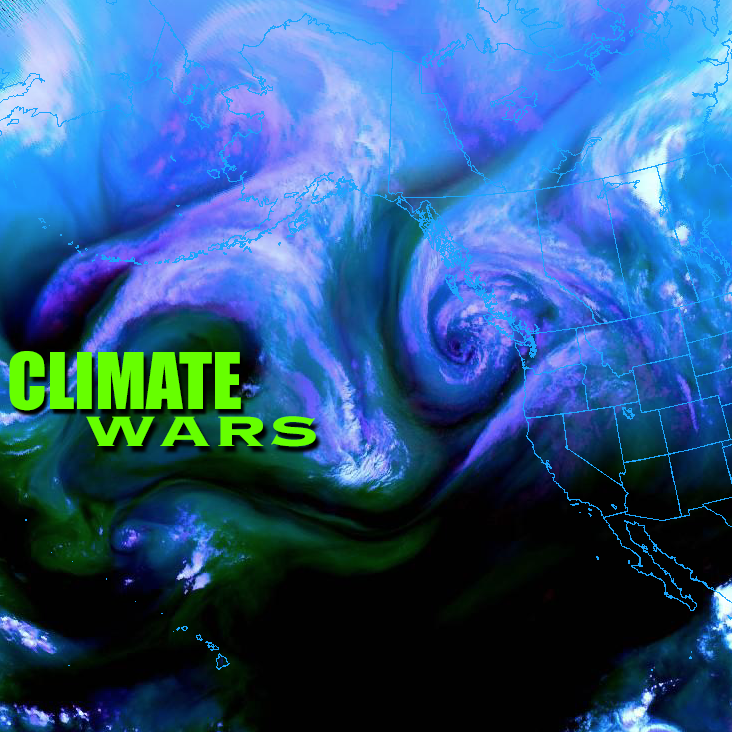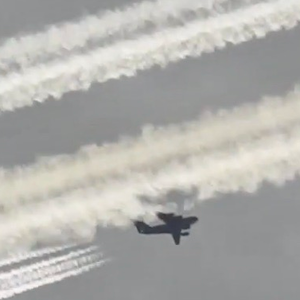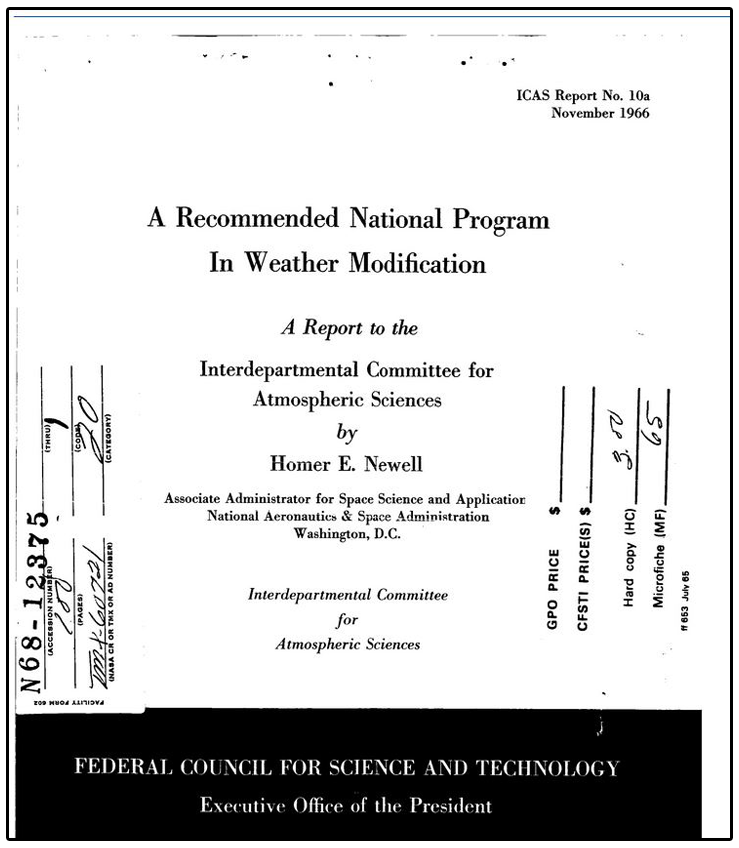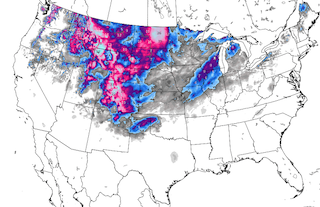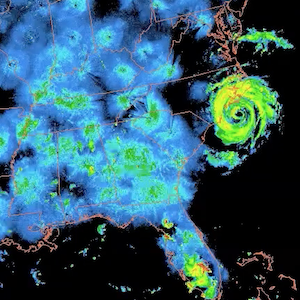Orthomolecular therapy with high-dose Vitamin C and colloidal silver. I make sure I have access to both here.
Nano silver is undoubtedly better, but I think the differential is being hyped by vendors. Same thing. Just smaller particles. Regular colloidal silver will work well, particularly if you are ozonating it prior to use. I’ve used it myself over the years to nip plenty of low-grade infections before they get worse. I have two machines from Sota.com — one for making colloidal silver, the other for ozonation. Make it in my kitchen. Works every time.
Pentagon Focus Is on the Climate As They Blow Apart Another Storm in California
Those that believe the US Department of Defense would ask for the public’s permission before they would interfere with the climate should wake up to reality. Take a good look at the satellite photo below. You don’t need to know much about meteorology to see what looks like giant paint brush strokes through the image from just off the California coast all the way through the western states into Canada. This effect is due to massive aerosol spraying of the incoming storm front, once again robbing California of desperately needed precipitation.
Though considerable moisture passed over Northern California all day on October 14th, 2014, not a drop has fallen as of the penning of this article. The first waves of moisture from the incoming front were completely migrated over the parched state by massive aerosol spraying over the tops of the clouds. From below, the cloud cover is largely featureless when the aerosol spraying is the heaviest. The spraying effectively melts the cloud cover together into a blended canopy of toxic aerosols and natural clouds. The rainless aerosolized clouds then migrate inland for hundreds or thousands of miles. This is the goal of solar radiation management, to create massive areas of cloud cover to block the sun. This greatly diminishes rain from falling where it would have and causes it to migrate further where it may eventually come down somewhere else in a deluge. So where does the US military fit into this equation? As the ongoing global climate engineering becomes impossible to hide, the military is beginning to admit they are indeed focused on the climate as a primary threat to US national security. In reality, the military is using climate engineering as a weapon against populations around the globe, this includes the US.
Dane Wigington
geoengineeringwatch.org
Pentagon Views Global Warming as an ‘Immediate’ Security Threat
Source: Mashable
The Defense Department sees global warming as a challenge that “poses immediate risks” to national security, rather than one that will rear its head only in the future.
This shift in thinking comes as the sprawling department puts in place a wide range of measures to ensure that its bases do not sink below the sea as the oceans rise, that its weapons systems still work in a variety of extreme weather conditions, and that it is prepared to deal with increased demands for humanitarian assistance and regional instability.
Defense Secretary Chuck Hagel unveiled the department’s “2014 Climate Change Adaptation Roadmap” in a speech at a regional defense ministers meeting in Peru on Monday.
“The loss of glaciers will strain water supplies in several areas of our hemisphere,” Hagel said. “Destruction and devastation from hurricanes can sow the seeds for instability. Droughts and crop failures can leave millions of people without any lifeline, and trigger waves of mass migration.”
We have already seen these events unfold in other regions of the world, and there are worrying signs that climate change will create serious risks to stability in our own hemisphere. Two of the worst droughts in the Americas have occurred in the past ten years … droughts that used to occur once a century.
The roadmap outlines the many ways in which climate change is already affecting the U.S. military, from increased flooding at the massive Navy and Air Force bases in the Hampton Roads, Virginia, area to melting permafrost underneath military training grounds in Alaska.
The military is completing a survey to assess the vulnerability of more than 7,000 military bases and other facilities, including more rigorous studies of bases that are considered to be at high risk from sea level rise. In the Hampton Roads area, for example, sea level is expected to rise by at least 1.5 feet by 2050, making storm surge flooding far more routine and damaging.
An analysis by the science research and journalism organization Climate Central found that, in the Hampton Roads area, there is a 100% likelihood of a flood reaching or exceeding five feet above the high tide line by 2070. This scenario would put nearly half of Joint Base Langley-Eustis under water. That base is home to a squadron of expensive F-22 fighter jets.
According to the group’s report, sea level rise along coastal Virginia could amount to between four and nearly five feet by 2100.
“In our defense strategy, we refer to climate change as a ‘threat multiplier’ because it has the potential to exacerbate many of the challenges we are dealing with today — from infectious disease to terrorism.
We are already beginning to see some of these impacts,”
We are already beginning to see some of these impacts,” Hagel wrote in the forward to the report, which was also published as a blog post on the White House website. “A changing climate will have real impacts on our military and the way it executes its missions.”
In the report, Hagel references the political controversy surrounding climate science, with many Republicans in Congress who don’t recognize the basic scientific link between manmade greenhouse gas emissions and global warming. “Politics or ideology must not get in the way of sound planning,” he says.
Our armed forces must prepare for a future with a wide spectrum of possible threats, weighing risks and probabilities to ensure that we will continue to keep our country secure. By taking a proactive, flexible approach to assessment, analysis and adaptation, the Defense Department will keep pace with a changing climate, minimize its impacts on our missions, and continue to protect our national security.
Many of the vulnerabilities discussed in the roadmap have been known for some time, since reports such as the Quadrennial Defense Review have addressed climate change’s potential impacts on military operations and readiness before.
What is unique in this report, however, is that it represents a tactical shift for the Pentagon, away from a long-term planning perspective on climate change, and toward one that also recognizes that climate change impacts, from extreme weather events like heat waves to sea level rise, are already affecting military readiness and mission demands.
While the military has long considered climate change to be a “threat multiplier” that is likely to drag the U.S. into a greater number of rapid humanitarian relief operations and weaken already fragile governments, the new report indicates that the Pentagon is also concerned about its impacts on the readiness of U.S. forces and changing requirements for new and expensive weapons systems.
The roadmap even notes the possibility that climate change, by altering the distribution of freshwater resources around the world, could make it more difficult for the military to ensure its personnel have adequate food and water, both in times of peace and war.
Although scientists have not yet firmly established a climate change connection to the ongoing California drought, it has already affected military training operations by increasing the number of high fire risk days, as well as excessive heat days, at military bases in the state. California is having its warmest year on record so far, after having its driest year.
Hagel’s speech also looked forward to the next round of U.N.-sponsored climate treaty talks, which will take place in Lima, Peru in December. “Defense leaders must be part of this global discussion,” Hagel said.
In an interview with Mashable on October 9, Manuel Pulgar-Vidal, Peru’s environment minister and the president of the upcoming climate talks, said a key goal of the negotiations will be to emerge with a draft global climate agreement. Without that, he said, “we are going to create a lot of frustration.”
The Lima talks will be followed by a high stakes round of negotiations in Paris in 2015, at which time a new treaty is supposed to be signed and slated to go into effect by 2020.
Source: Mashable
The Human Race Is Descending into Extinction: A Former Reagan Cabinet Official Speaks Out
Dr. Paul Craig Roberts was Assistant Secretary of the Treasury for the Reagan administration. Mr. Roberts has constantly been an outspoken voice of facts and reason in an increasingly chaotic and criminal world run by global powers that are unarguably completely out of control. About 4 weeks before the article below was released, I communicated with Dr. Roberts on the issue of global geoengineering (as I am sure some others have also). I expressed to him that his voice would bring great credibility to the cause of raising public awareness on the critical climate engineering issue. Though he stated his reluctance to address the subject as it was not his area of expertise, true to his courageous character, Dr Roberts put out the article below which covered the climate engineering issue (along with other critical subjects) shortly after our exchange.
Dane Wigington
GeoengineeringWatch.org
Ignored Reality Is Going to Wipe Out the Human Race
Source: Paul Craig Roberts
To inform people is hard slugging. Everything is lined up against the public being informed, or the policymakers for that matter. News is contaminated by its service to special interests and hidden agendas. Many scientists or their employers are dependent on federal money. Even psychologists and anthropologists were roped into the government’s torture and occupation programs. Economists tell lies for corporations and Wall Street. Plant and soil scientists tell lies for agribusiness and Monsanto. Truth tellers are slandered and persecuted. However, persistence can eventually win out. In the long-run, truth sometimes emerges. But not always. And not always in time.
I have been trying to inform the American people, economists, and policymakers for more than a decade about the adverse impacts of jobs offshoring on the US economy. The word has eventually gotten out. Last week I was contacted by 8th grade students competing for their school in CSPAN’s StudentCam Documentary Contest. They want to interview me on the subject of jobs offshoring for their documentary film.
America is a strange place. Here are eighth graders far ahead of the economics profession, the President, the Congress, the Federal Reserve, Wall Street, and the financial press in their understanding of one of the fundamental problems of the US economy. Yet, people say the public schools are failing. Obviously, not the one whose students contacted me.
Is it too late? I know much, but not all. So this is not the final word. I think it might be too late. When skilled jobs are sent abroad, the skills disappear at home. So do the supply chains and the businesses associated with the skills. Things close down, and abilities are lost. Why take a major in college for a job that is offshored. A culture disappears.
But we can start them back up, right? Perhaps not. When a First World country exports its technology and know-how abroad to a Third World country in order to benefit from lower cost labor, how does the First World country get the work back? Living standards and the cost of living in Third World countries are much lower than in First World countries. The populations of First World countries cannot pay their mortgages, car payments, student loans, medical care, and grocery bills with the wages of Third World countries.
When First World wages drop, mortgage, car, credit card, and student loan payments do not drop. Americans cannot live on Chinese, Indian, and Indonesian wages. Once the technology and know-how is transferred, the low wage country has the advantage in the absence of tariff protection.
For America to revive, our economy would have to be walled off with high tariffs, and subsidies would have to be provided in order to recreate US industry and manufacturing. But many corporations now produce offshore, and America is broke. The government has been $1 trillion dollars in the hole each year for the last 5 years.
Jobs offshoring diminished the US tax base. When a job is sent abroad, so is that job’s contribution to US GDP and tax base. When millions of jobs are sent abroad, US GDP and tax base cannot support government spending levels. To the extent that there are any replacement jobs, they are in lowly paid domestic services, such as waitresses, bartenders, retail clerks, and hospital orderlies. These jobs do not provide a tax base or consumer spending power comparable to manufacturing jobs and tradable professional services such as software engineering and information technology.
Republicans and increasingly Democrats, as both parties are dependent on the same sources of campaign contributions, blame “entitlements.” By entitlements they mean welfare.
In fact, entitlements consist of Social Security and Medicare. Entitlements are funded by the payroll tax, approximately 15% of payroll. The fact that a person pays the payroll tax all his working life is why the person is entitled to Social Security and Medicare if they live to retirement age. Welfare, such as food stamps and housing subsidies, are a small part of the federal budget and are not entitlements.
Ever since President Reagan was betrayed three decades ago by Alan Greenspan and David Stockman, both of whom sold out to Wall Street and raised the Social Security payroll tax above what was needed to pay Social Security benefits in order to protect Wall Street’s stock and bond portfolios from exaggerated deficit fears, Social Security payroll tax revenues have exceeded Social Security payments. As of today, Social Security revenues exceed payments to beneficiaries by an accumulated $2 trillion. The money was used by the federal government to pay for its wars and other spending programs. The Social Security Trust Fund holds non-marketable IOUs from the Treasury. These IOUs can only be made good from an excess of tax revenues over expenditures or by the Treasury selling $2 trillion in bonds, notes, and bills and paying off its IOUs to the Social Security Trust Fund. This is not going to happen.
The Federal Reserve could not care less about the US population. The Fed was established for the purpose of protecting and aiding banks. Currently, the Fed, as if America were a Banana Republic which America appears to be becoming, is printing one thousand billion dollars per year in order to support the banks and to finance the federal deficit.
This is bad news for Americans, as it means that their fiat money is being created at a far greater rate than the demand for the dollar. The implication for our future is a drop in the dollar’s value. As there are no jobs, a drop in the dollar’s value means high inflation on top of unemployment and double the misery of the Great Depression.
As bad as this is, it is minor compared to the destruction of the planet’s environment. Online information shows that the Gulf of Mexico ecosystem is in crisis after the BP spill and use of Corexit, a dispersant used to hide, not clean up, the spilled oil. http://www.opednews.com/articles/Gulf-ecosystem-in-crisis-a-by-Dahr-Jamail-Corporation-BP_Ecosystems_Gulf-Oil-Spill-Disaster_Gulf-Shrimping-Industry-131020-15.html
The Fukushima catastrophe has hardly begun. Yet already the radioactive water pouring into the Pacific Ocean has made fish dangerous to eat unless a person is willing to accept a higher risk of cancer.
Fukushima has the potential of making Japan uninhabitable and of polluting the air, water, and soil of the US with radioactivity. Yet the crisis is seldom mentioned in the US media. In Japan the government just passed a law that could be used to imprison Japanese journalists who report truthfully on the dire situation.
Take the time to familiarize yourself with the online information about Fukushima. According to the presstitute media, Americans face threats from Iran and Syria and from whistleblowers such as Edward Snowden. The real threats are simply not in the news.
If you search Fukushima, you will find information that the presstitute media hides from you. See for example, http://www.globalresearch.ca/28-signs-that-the-west-coast-is-being-absolutely-fried-with-nuclear-radiation-from-fukushima/5355280
There are a number of other threats to the environment on which our lives depend. One is the effort to extract more productivity from the soil by use of GMOs. Monsanto has altered the genes of several crops so that the crops can be sprayed with RoundUp to eliminate weeds. The results have been to deplete the soil of nutrients, to destroy the micro-biology of the soil so that new plant diseases and funguses are activated, and to produce superweeds that require heavier doses of the glyphosate in RoundUp. The heavier dose of RoundUp worsens the aforementioned problems. US agricultural soil is losing its potency.
Now we come to chemtrails, branded another “conspiracy theory.” http://en.wikipedia.org/wiki/Chemtrail_conspiracy_theory However, the US government’s efforts to geo-engineer weather as a military weapon and as a preventative of global warming appear to be real. The DARPA and HAARP programs are well known and are discussed publicly by scientists. See, for example, http://news.sciencemag.org/2009/03/darpa-explore-geoengineering Search Chemtrails, and you will find much information that is kept from you. See, for example, http://www.globalresearch.ca/chemtrails-a-planetary-catastrophe-created-by-geo-engineering/5355299 and https://geoengineeringwatch.org
Some describe chemtrails as a plot by the New World Order, the Rothchilds, the Bilderbergers, or the Masons, to wipe out the “useless eaters.” Given the amount of evil that exists in the world, these conspiracy theories might not be as farfetched as they sound.
However, I do not know that. What does seem to be possibly true is that the scientific experiments to modify and control weather are having adverse real world consequences. The claim that aluminum is being sprayed into the atmosphere and when it comes to earth is destroying the ability of soil to be productive might not be imaginary. Those concerned about chemtrails say that weather control experiments have deprived the western United States of rainfall, while sending the rain to the east where there have been hurricane level deluges and floods.
In the West, sparse rainfall and lightning storms without rain are resulting in forests drying out and burning down. Deforestation adversely affects the environment in many ways, including the process of photosynthesis by which trees convert carbon dioxide into oxygen. The massive loss of forests means more carbon dioxide and less oxygen. Watershed and species habitat are lost, and spreading aridity further depletes ground and surface water. If these results are the consequences of weather modification experiments, the experiments should be stopped.
In North Georgia where I spend some summers, during 2013 it rained for 60 consecutive days, not all day, but every day, and some days the rainfall was 12 inches–hurricane level–and roads were washed out. I received last summer 4 automated telephone warnings from local counties not to drive and not to attempt to drive through accumulations of water on the highways.
One consequence of the excess of water in the East is that this year there are no acorns in North Georgia. Zilch, zero, nada. Nothing. There is no food for the deer, the turkeys, the bear, the rodents. Starving deer will strip bark from the trees. Bears will be unable to hibernate or will be able only to partially hibernate, forced to seek food from garbage. Black bears are already invading homes in search of food.
Unusual drought in the West and unusual flood in the East could be coincidental or they could be consequences of weather modification experiments.
The US, along with most of the world, already had a water problem prior to possible disruptions of rainfall by geo-engineering. In his book, Elixir, Brian Fagan tells the story of humankind’s mostly unsuccessful struggle with water. Both groundwater and surface water are vanishing. The water needs of large cities, such as Los Angeles and Phoenix, and the irrigation farming that depends on the Ogallala aquifer are unsustainable. Fagan reminds us that “the world’s supply of freshwater is finite,” just like the rest of nature’s resources. Avoiding cataclysm requires long-range thinking, but humanity is focused on immediate needs. Long-range thinking is limited to finding another water source to deplete. Cities and agriculture have turned eyes to the Great Lakes.
Los Angeles exists because the city was able to steal water from hundreds of miles away. The city drained Owens Lake, leaving a huge salt flat in its place, drained the Owens Valley aquifer, and diverted the Owens River to LA via aqueduct. Farming and ranching in the Owens Valley collapsed. Today LA takes water from the Colorado River, which originates in Wyoming and Colorado, and from Lake Perris 440 miles away.
Water depletion is not just an American problem. Fagan reports that “underground aquifers in many places are shrinking so rapidly that NASA satellites are detecting changes in the earth’s gravity.”
If the government is experimenting with weather engineering, scientists are playing God when they have no idea of the consequences. It is a tendency of scientists to become absorbed by the ability to experiment and to ignore unintended consequences.
Readers have asked me to write about Fukushima and chemtrails because they trust me to tell them the truth. The problem is that I am not qualified to write about these matters with anything approaching the same confidence that I bring to economic, war and police state matters.
The only advice I can give is that when you hear the presstitute media smear a concern or explanation as “conspiracy theory,” have a closer look. The divergence between what is happening and what you are told is so vast that it pays to be suspicious, cynical even, of what “your” government and “your” presstitute media tell you. The chances are high that it is a lie.
Source: Paul Craig Roberts
‘I would do anything to refuse to go there’ – Dallas nurse
lashes out
at
hospital over Ebola response
Concerns are being raised further still about how health care officials have handled the presence of Ebola in the United States, with one Dallas, Texas nurse now directly blaming a local hospital for failing to halt the spread of the disease.
On Thursday, Dallas nurse Briana Aguirre told “Today” show host Matt Lauer that she “can no longer defend” the facility where she works, Texas Health Presbyterian Hospital, from allegations that officials there weren’t properly prepared to handle the deadly Ebola virus when a Liberian national with the disease was administered late last month. Two nurses have since contracted the deadly virus.
“I believe they should have known they were not handling this well, this Ebola crisis,” Aguirre told Lauer while flanked by her attorney. “They should have known that it was getting out of hand. They should have called in more help, even to make a public plea and say, ‘Help us. Help us get the supplies we need. Help us get the nurses the education and training they need.’”
“Knowing what I know, I would try everything and anything to refuse to go there to be treated,” she said. “I would feel at risk by going there. If I don’t actually have Ebola, I may contract it there. I would do anything to refuse to go there.”
“I watched them violate basic principles of nursing care, of medical care,” Aguirre said.
Thomas Eric Duncan, 42, visited Texas Health Presbyterian Hospital on September 26 after traveling from West Africa and was soon after discharged with antibiotics despite telling health officials that he had just been in the epicenter of the current Ebola outbreak. Duncan was administered again on Sept. 30 and died from the disease last Wednesday, October 8. Two nurses from Dallas who cared for Duncan have since contracted Ebola and fears of further cases worsened this week when it was revealed on Wednesday that one of them, 29-year-old Amber Vinson, flew on a commercial airliner from Cleveland to Dallas the day before she was diagnosed, but not before first informing health officials.
On Wednesday evening, the director of the Centers for Disease Control and Prevention again downplayed concerns of a full-blown epidemic erupting in the United States and said the CDC was working diligently to contain the virus.
Yet both the CDC and Texas Health Presbyterian Hospital are continuing to be heavily blamed for their alleged ineptitude, and new accusations suggest that officials may indeed have ignored several warnings that would have helped them contain the disease had they acted appropriately.
According to CNN, Vinson, the second Dallas nurse to contract Ebola from Duncan, informed the CDC that she planned to fly by air from Ohio to Texas last Friday, two days after the Liberian died at Presbyterian, but was concerned because her temperature was 99.5 Fahrenheit (37.5 Celsius). Since that reading was below the CDC’s temperature threshold of 100.4F (38C), CNN first reported, a source claims “she was not told not to fly.”
“She wasn’t bleeding or vomiting,” Frieden explained after the news surfaced on Wednesday. “The level of risk around her would be extremely low, but because of the extra margin of safety, we will be contacting [all those who were on the flight.”
Nevertheless, allegations of misconduct directed at multiple health offices continue to mount, and now authorities in Texas have even offered an official apology ahead of an emergency hearing being held in Washington on Thursday.
“We did not correctly diagnose his symptoms as those of Ebola. We are deeply sorry,” Dr. Daniel Varga, the chief clinical officer for Texas Health Services, said in written testimony to the House Energy and Commerce Committee.
“Unfortunately, in our initial treatment of Mr. Duncan, despite our best intentions and a highly skilled medical team, we made mistakes,” reads the prepared testimony from Varga, which was released in advance of Thursday’s hearing since he will not be in attendance.
Apologies out of Texas come not only after the “Today” show raised new concerns during Thursday morning’s interview with Aguirre, but also on the heels of a statement released this week by the group National Nurses United concerning the situation at Presbyterian when Duncan arrived.
“No one knew what the protocols were or were able to verify what kind of personal protective equipment should be worn and there was no training,” the statement reads in part.
“For their necks, nurses had to use medical tape, that is not impermeable and has permeable seams, to wrap around their necks in order to protect themselves, and had to put on the tape and take it off on their own,” it continued. “Nurses had to interact with Mr. Duncan with whatever protective equipment was available, at a time when he had copious amounts of diarrhea and vomiting which produces a lot of contagious fluids.”
The hospital fired back by saying this week that “All specimens were placed into closed specimens bags and placed inside a plastic carrier that travel through a pneumatic system,” and that, “At no time did Mr. Duncan’s specimens leak or spill – either from their bag or their carrier – into the tube system.”
“Patient and employee safety is our greatest priority and we take compliance very seriously,” hospital spokesman Wendell Watson said in a statement. “We have numerous measures in place to provide a safe working environment, including mandatory annual training and a 24/7 hotline and other mechanisms that allow for anonymous reporting.”
“Our nursing staff is committed to providing quality, compassionate care, as we have always known, and as the world has seen firsthand in recent days. We will continue to review and respond to any concerns raised by our nurses and all employees.”
Meanwhile, how exactly Vinson is being handled by health officials continues to prompt criticism: when the nurse was moved from Dallas to Emory University Hospital in Atlanta on Wednesday, she was accompanied by a team of individuals in haz-mat suits and, bizarrely, a man in a button-down shirt holding a clipboard and wearing seemingly no protection at all.
“‘You need a hazmat suit? Nah, I’m good. I got a clipboard” former US congressman and radio host Joe Walsh opined, according to the Telegraph. On Thursday, Phoenix Air Vice President Randy Davis told NBC News that the man’s role was to “oversee the process of transport including on the tarmac,” and that, “Part of our protocol is to have 1 person NOT in a bio-Hazard suit. ”
In addition to Vinson, another nurse, Nina Pham, is currently being treated for Ebola after caring for Mr. Duncan. A cameraman for NBC News who contracted the disease in West Africa is also receiving treatment at a facility in Nebraska, but at this point the two Dallas nurses remain the only US citizens to be diagnosed with the disease on American soil.
‘Assassination’ of Public Health Systems Driving Ebola Crisis, Experts Warn
As the official West African death toll from the worst Ebola outbreak in recorded historynears 5,000, global concerns about the highly infectious disease continue to mount. Analysts and medical providers, from Liberia to the United States, say that in order to address the crisis, the international community must tackle the real culprit: western-driven economic policies defunding public health systems around the world, particularly in the countries hit hardest by the outbreak.
“The neoliberal economic model assassinated public infrastructure,” said Emira Woods, a Liberia native and social impact director at ThoughtWorks, a technology firm committed to social and economic justice, in an interview with Common Dreams. “A crisis of the proportion we’ve seen since the beginning of the Ebola catastrophe shows this model has failed.”
Gutting of West African Public Health Systems
Since the 1980s, western financial institutions have given loans to third world governments on the condition those states impose austere domestic reforms and roll back public services. This approach is encapsulated in the 1981 World Bank report Accelerated Development in Sub-Saharan Africa, which presses for “structural adjustments,” including rapid privatization, shrinking of public services and subsidies, and a shift towards export dependency as a solution to “slow economic growth.”
“In West Africa, the resulting neoliberal economic policies sought to promote growth and prosperity through structural adjustment programs (SAPs) that generally involved contraction of government services, renewed export orientation on crops or goods deemed to have a comparative advantage, privatization of parastatal organizations, removal or reduction of many subsidies and tariffs, and currency devaluations,” explain Macalester College Professor William Moseley and colleagues in a paper for the journal Proceedings of the National Academy of Sciences of the United States of America.
“What you had was a shift of public expenditures from health care, school, and essential services to a model of economic development driven by the World bank and International Monetary Fund, which said that public service provision was not passage to development, and services should be privatized,” said Woods. “There was this notion that poor people can pay, and services are better provided by the private sector.”
While years of war played a role in weakening public systems, it is the “war against people, driven by international financial institutions” that is largely responsible for decimating the public health care system, eroding wages and conditions for health care workers, and fueling the crisis sweeping West Africa today, says Woods. “Over the past six months to a year there have been rolling health care worker strikes in country after country—Nigeria, Sierra Leone, and Liberia,” said Woods. “Nurses and doctors are risking and losing their lives but don’t have protective gear needed to serve patients and save their own lives. They are on the front lines and have not had their voices heard.”
Even the World Health Organization, which is tasked by the United Nations with directing international responses to epidemics, acknowledges the detrimental impact these policies have had on public health systems. “In health, SAPs affect both the supply of health services (by insisting on cuts in health spending) and the demand for health services (by reducing household income, thus leaving people with less money for health),” states the organization. “Studies have shown that SAPs policies have slowed down improvements in, or worsened, the health status of people in countries implementing them. The results reported include worse nutritional status of children, increased incidence of infectious diseases, and higher infant and maternal mortality rates.”
A “Highly Vulnerable” World
Medical responders have criticized the international community for failing to aggressively address the crisis. In a press statement issued in late August, Brice de le Vingne, Doctors Without Borders director of operations, slammed western states for their isolationist policies towards the epidemic: “Self-protection is occupying the entire focus of states that have the expertise and resources to make a dramatic difference in the affected countries. They can do more, so why don’t they?”
The WHO has recently suffered severe budget cuts that have left it weakened, under-staffed, and incapable of adequately responding to the international emergency. “There’s no doubt we’ve not been as quick and as powerful as we might have been,” Dr. Marie-Paule Kieny, a WHO assistant director general, told the New York Times in an article examining the cuts.
Critics say the de-funding of public health system within western states is putting populations at risk. Despite the efforts of the Centers for Disease Control and the Obama administration to assure the U.S. public of a robust response, nurses tell a different story. Workers with the union National Nurses United have repeatedly warned that the for-profit U.S. health care system is in fact ill-prepared for an Ebola outbreak, with U.S. hospitals lacking basic protocols, training, and protective gear.
Meanwhile, Woods warns, the U.S.’s militarized response to the Ebola crisis in West Africa—including Obama’s authorization on Thursday for the Pentagon to deploy reserve and National Guard troops—raises serious concerns. “If you think about the costs of sending in the military compared to putting resources into nurses and doctors and rebuilding public health infrastructure that will last, U.S. tax payers should be really questioning the tax dollars being spent and what the long-term implications are.”
“The world will remain highly vulnerable to this and similar outbreaks unless all countries prioritize the universal right to health, including the international obligation of rich countries to pay their fair share in ensuring that basic health capacity is available everywhere,” the global justice organization U.S. Africa Network argues. “The failure to do so is a violation of human rights and our common humanity.”
Failing Humans and Planet, EPA Greenlights ‘Agent Orange’ Herbicide
In a press statement, the agrochemical giant said that their Enlist Duo herbicide is now registered for use on Dow Enlist-brand genetically engineered corn and soy crops, which the U.S. Department of Agriculture (USDA) approved less than a month ago.
The herbicide is made from a combination of glyphosate, the main ingredient in Monsanto’s Roundup, and 2,4-D, a component of the toxic Agent Orange herbicide used during the Vietnam War, which has been linked to numerous health issues including increased risks of non-Hodgkin’s lymphoma, Parkinson’s and immune system problems.
By the USDA’s own estimate, approval of the herbicide and crop system will increase the annual use of 2,4-D from 26 million pounds to 176 million pounds.Organic advocates and environmental groups were quick to condemn the move, saying that the use of Enlist Duo will threaten the health of humans and environment, promote the expanded use of genetically modified seeds (or GMOs) and spur the growth of more herbicide-resistant weeds.
“The EPA’s approval of this highly toxic herbicide flies in the face of scientific evidence that not only are these chemicals toxic to humans and the environment, but that the escalation of their use will only lead to the evolution of a whole new crop of herbicide-resistant superweeds,” said Ronnie Cummins, international director of the Organic Consumers Association.
Scientists and food safety experts have long warned that such herbicides will only worsen the problem of “superweeds” while at the same time creating a more toxic and less sustainable agriculture system. As the agrochemical giant itself noted, “tens of millions of acres of American farmland are infested with glyphosate-resistant weeds, and the problem has grown worse every year.” Weed infestation doubled between 2009 and 2013, it says.
“The EPA has failed in its mission to protect the environment, just as the biotech industry’s toxic, chemical-intensive industrial agriculture has failed to deliver on its promises of higher yields and higher profits for farmers, and fewer poisons for the environment,” Cummins continued.
Further, conservation watchdog groups charge that the EPA is “ignoring its legal duty” to protect key animal species in their expeditious approval of “two known dangerous pesticides.”
Violating the Endangered Species Act, the EPA failed to consult with the U.S. Fish and Wildlife Service on the negative impacts to such species before issuing their approval, Hartl added. CBD estimates that the approval now puts over 20 endangered species in harm’s way.”This was an unbelievably foolish decision — Enlist Duo will harm dozens of endangered species, and is another nail in the coffin for the monarch butterfly,”said Brett Hartl, endangered species policy director at the Center for Biological Diversity (CBD). “Once again the EPA has turned a blind eye to endangered species, clean water and human health in its apparently endless desire to placate multinational pesticide companies.”
Over half a million people submitted public comment this summer urging the EPA not to green light the pesticide mix. In the past two weeks alone an additional quarter of a million people signed a White House petition calling on President Obama to block the approval.
Condemning the federal office for “turn[ing] its back on those it purports to protect —the American people and our environment,” the Center for Food Safety is vowing to take legal action “to stop the commercialization of these dangerous crops.”
Meanwhile, Organic Consumers Association and other groups say this will only embolden their state-by-state campaigns to pass mandatory GMO-labeling laws and other agriculture policies “that promote organic, regenerative agriculture over an industrial model that is destroying our health, polluting our environment, and has been identified as one of the leading causes of global warming.”
Radiation levels at Fukushima rise to record highs after typhoon
The amount of radioactive water near the Fukushima Daiichi nuclear plant has risen to record levels after a typhoon passed through Japan last week, state media outlet NHK reported on Wednesday.
Specifically, levels of the radioactive isotope cesium are now at 251,000 becquerels per liter, three times higher than previously-recorded levels. Cesium, which is highly soluble and can spread easily, is known to be capable of causing cancer.
Meanwhile, other measurements also show remarkably high levels of tritium – another radioactive isotope of hydrogen. Samples from October 9 indicate that there are 150,000 becquerels of tritium per liter in the groundwater near Fukushima, according to Japan’s JIJI agency. Compared to levels recorded last week, that’s an increase of more than 10 times.
Additionally, “materials that emit beta rays, such as strontium-90, which causes bone cancer, also shattered records with a reading of 1.2 million becquerels, the utility said of the sample,” JIJI reported.
While cesium is considered to be more dangerous than tritium, both are radioactive substances that authorities would like to keep from being discharged into the Pacific Ocean in high quantities.
For now, extra measures to contain the issue are not on the table, since “additional measures have been ruled out since the depth and scope of the contaminated water leaks are unknown, and TEPCO already has in place several measures to control the problem, such as the pumping of groundwater or walls to retain underground water,” according to the IANS news service.
‘Shot in the heart’: Israeli army kills 13yo Palestinian boy
A Palestinian boy was shot in the chest point-blank and later died amid a confrontation between Israeli forces and stone-throwing youths in a village of the occupied West Bank, according to local media and medical sources.
READ MORE: UK MPs pass motion to recognize Palestine as a state
Bahaa Badr, 13, was fatally shot by the Israeli Defense Forces (IDF) as the troops made their way to Beit Liqya village in the West Bank, located near the border with Israel, Reuters reported citing medical sources and local residents.
Badr was shot from a close range into the heart area and died shortly after the impact, Palestinian Ma’an news agency quoted another source as saying.
Upon entering the village, Israeli troops were met by Palestinian protesters who began throwing stones at them. It is still unclear whether the boy took part in the protest.
Israel has referred to the demonstration as an “illegal riot,” saying that demonstrators threw Molotov cocktails at soldiers as they were leaving the village.
In response, troops began shooting live ammunition rounds, according to an Israeli military spokesperson, who added that the incident will be investigated.
Tensions between Israelis and Palestinians have been running extremely high since the start of Israel’s seven-week war in Gaza in July, which took the lives of more than 2,000 Palestinians – mostly civilians – and over 70 Israelis, mostly soldiers.
Back in April, US-mediated peace talks between Israel and the Palestinians broke down.
Meanwhile, British MPs made a historic step on Monday evening, as the British Parliament voted in favor of a symbolic move to recognize Palestine as an official state.
At the same time, the international community has condemned Israel’s plans for further expansion into the occupied Palestinian territories. UN Secretary-General Ban Ki-moon has expressed frustration at Israel’s settlement program, which is planning 600 new homes in East Jerusalem. The new units are set to expand four existing settlements in the Palestinian city.
“I once again strongly condemn the continued settlement activity by Israel,” the UN chief told journalists after a meeting with Palestinian Prime Minister Rami Hamdallah in Ramallah on Monday.
The Israeli government also plans to seize one square kilometer of farmland near Bethlehem, which is “intended for the construction of settlement units, parks, a synagogue and agricultural roads,” according to a report by the Palestinian news agency WAFA.
READ MORE: Israel’s plan to build 600 new homes in E. Jerusalem earns UN’s anger
Hamas leader calls on Muslims to ‘defend’ Jerusalem’s Al-Aqsa mosque
Hamas chief Khaled Meshaal has urged Muslims to “defend” the Al-Aqsa mosque in Jerusalem after Israeli forces restricted the entrance for Palestinians. He accused Israel of trying to seize the site, which is considered holy for both Muslims and Jews.
READ MORE: Clashes erupt in Jerusalem as Palestinians ‘denied’ access to holy mosque
“We call on all our people inside the country to hurry up to al-Aqsa to defend it,” Meshaal said in a statement from Doha, Qatar.
“We call on the nation to be angry and to send a message of painful anger to the world that the Palestinian people, the Arab and Muslim nation, will not be silent at the Israeli crime,”Meshaal added.
When asked if such a call might trigger another conflict soon after the deadly 2014 Gaza war, the Hamas leader said: “Nobody wants a war, but it’s our right to resist and preserve our rights. We are under occupation…We have been resisting for one hundred years and will continue.”
“Al-Aqsa is worth us becoming martyrs for, and anyone who can carry a weapon in the region should go and defend it, as this is the true meaning of jihad,” Meshaal added, prompting alarm from both media and the region’s politicians.
Israeli Prime Minister Benjamin Netanyahu has denied all the assumptions, saying the extremists are to blame for the violence.
“I am committed and Israel is committed to maintaining the status quo exactly as it has been for many decades,” he said on Monday. “What we’re seeing are Palestinian extremists who are instigating violence through incitement. The incitement is spread by false and baseless rumors that we are threatening the Muslim holy places. Nothing could be further from the truth.”
Netanyahu said Israel would continue to scrupulously maintain the protection of holy sites and the right of all religions to worship in their holy places.
According to Meshaal, however, Israel is trying to use the regional turmoil to take over the mosque.
Jerusalem’s Grand Mufti Muhammad Hussein has insisted that the compound is “a holy site for Muslims only.”
Israeli Public Security Minister Yitzhak Aharonovitch threatened Tuesday to close the compound entirely if members of the two faiths could not pray there peacefully.
“We want [the compound] to stay open for Muslims and Jews, but if Jews can’t go there, neither can Muslims,” the minister was quoted as saying by military radio.
The latest outbreak of tensions over the holy site started in 2000, after Israeli politician Ariel Sharon’s visit to Al-Aqsa triggered a Palestinian uprising that lasted five years – the so-called Second Intifada.
Calling Russia ‘threat to humanity’ puts Obama’s sanity in doubt – Medvedev
The Russian PM has suggested that Obama’s charges against Russia were caused by a “brain aberration” and added that such rhetoric saddened him.
“I am very upset by the fact that President Obama, while speaking from the United Nations’ podium and listing the threats and challenges humanity is currently facing, put Ebola in first place, the Russian Federation second and the Islamic State organization was only in the third place. I don’t even want to comment on this, this is some sort of aberration in the brain,” Dmitry Medvedev said in an interview with CNBC television.
The top Russian official stressed that his country was not isolating itself from the rest of the world, but sought mutually beneficial cooperation with foreign nations. “We want to communicate with all civilized peoples on friendly grounds. Of course, this includes our partners from the United States of America, but for this the situation must be leveled,” Medvedev said.
However, the Russian PM also noted that the Western sanctions have inflicted considerable damage to Russia’s cooperation with the US, and without cancellation of this policy there can be no return to partnership.
“Let us be frank, it was not us who invented these sanctions, they were invented by our partners in the international community. As our saying goes, let God be their judge. Without any doubt we can survive these sanctions, I am sure that sometime later the sanctions will evaporate, simply cease to exist. But there is no doubt that they have dealt some damage to our relations.”
Medvedev ruled out the possibility of an immediate reset in relations between Russia and the West, adding that he expected the process to composed of at least two stages.
“What sort of reset can be there under such conditions? We must first distance from this all and return to a normal position, at least to the starting position and only then we can start elaborating on the development of relations in the future,” he said.
The Russian PM also stressed that Russia can and will find new partners for routine trade and normal investment projects.
Ukraine’s Neo-Nazis Demand Respect
For months, the New York Times and other major U.S. news outlets have insisted that it’s just Russian propaganda to say that a significant neo-Nazi presence exists inside Ukraine, but thousands of these “non-existent” neo-Nazis battled police on Tuesday outside the parliament building in Kiev demanding recognition of their Hitler-collaborating forebears.
The parliament, aware of the obvious public relations fiasco that would follow if it bowed to far-right demands to honor members of the Nazi-affiliated Ukrainian Insurgent Army (or UIA), defeated the proposal. That touched off riots by an estimated 8,000 protesters led by Ukraine’s right-wing Svoboda party and the Right Sektor.
Historians blame the UIA and other Ukrainian fascist forces for the extermination of thousands of Poles and Jews during World War II as these right-wing Ukrainian paramilitaries sided with the German Nazis in their fight against the Soviet Union’s Red Army. Svoboda and the Right Sektor have elevated UIA leader Stepan Bandera to the level of a Ukrainian national hero.
But Svoboda and Right Sektor activists are not just neo-Nazi street protesters. They were key figures in last February’s violent uprising that overthrew elected President Viktor Yanukovych and established a coup regime that the U.S. State Department quickly recognized as “legitimate.” Many far-right militants have since been incorporated into the Ukrainian military in its fight to crush resistance to the coup regime from ethnic Russians in Ukraine’s east.
Though played down by the Western press, the neo-Nazi affiliations of these militants have occasionally popped up in news stories, including references to displays of Nazi insignias, but usually these citations are mentioned only in passing or are confined to the last few paragraphs of lengthy stories or are dismissed as “Russian propaganda.”
But this neo-Nazi reality continues to be an inconvenient truth about the U.S.-backed coup regime that seized power in Kiev with the overthrow of Yanukovych on Feb. 22. Several government ministries, including national security, were given to these far-right elements in recognition of their key role in the putsch that forced members of Yanukovych’s government to flee for their lives.
The larger historical context is that Nazism has been deeply rooted in western Ukraine since World War II, especially in cities like Lviv, where a cemetery to the veterans of the Galician SS, a Ukrainian affiliate of the Nazi SS, is maintained. These old passions were brought to the surface again in the battle to oust Yanukovych and sever historic ties to Russia.
The muscle behind the U.S.-backed Maidan protests against Yanukovych came from neo-Nazi militias trained in western Ukraine, organized into 100-man brigades and dispatched to Kiev. After the coup, neo-Nazi leader Andriy Parubiy, who was commander of the Maidan “self-defense forces,” was elevated to national security chief and soon announced that the Maidan militia forces would be incorporated into the National Guard and sent to eastern Ukraine to fight ethnic Russians resisting the coup regime.
At War in the East
As the U.S. government and media cheered this “anti-terrorist operation,” the neo-Nazis and other right-wing battalions engaged in brutal street fighting against Russian ethnic rebels. Only occasionally did this nasty reality slip into the major U.S. news media. For instance, an Aug. 10 article in the New York Times mentioned the neo-Nazi paramilitaries at the end of a lengthy story on another topic.
“The fighting for Donetsk has taken on a lethal pattern: The regular army bombards separatist positions from afar, followed by chaotic, violent assaults by some of the half-dozen or so paramilitary groups surrounding Donetsk who are willing to plunge into urban combat,” the Times reported.
“Officials in Kiev say the militias and the army coordinate their actions, but the militias, which count about 7,000 fighters, are angry and, at times, uncontrollable. One known as Azov, which took over the village of Marinka, flies a neo-Nazi symbol resembling a Swastika as its flag.” [See Consortiumnews.com’s “NYT Discovers Ukraine’s Neo-Nazis at War.”]
The conservative London Telegraph offered more details about the Azov battalion in an articleby correspondent Tom Parfitt, who wrote: “Kiev’s use of volunteer paramilitaries to stamp out the Russian-backed Donetsk and Luhansk ‘people’s republics’… should send a shiver down Europe’s spine.
“Recently formed battalions such as Donbas, Dnipro and Azov, with several thousand men under their command, are officially under the control of the interior ministry but their financing is murky, their training inadequate and their ideology often alarming. The Azov men use the neo-Nazi Wolfsangel (Wolf’s Hook) symbol on their banner and members of the battalion are openly white supremacists, or anti-Semites.”
Based on interviews with militia members, the Telegraph reported that some of the fighters doubted the reality of the Holocaust, expressed admiration for Adolf Hitler and acknowledged that they are indeed Nazis.
Andriy Biletsky, the Azov commander, “is also head of an extremist Ukrainian group called the Social National Assembly,” according to the Telegraph article which quoted a commentary by Biletsky as declaring: “The historic mission of our nation in this critical moment is to lead the White Races of the world in a final crusade for their survival. A crusade against the Semite-led Untermenschen.”
In other words, for the first time since World War II, a government had dispatched Nazi storm troopers to attack a European population – and officials in Kiev knew what they were doing. The Telegraph questioned Ukrainian authorities in Kiev who acknowledged that they were aware of the extremist ideologies of some militias but insisted that the higher priority was having troops who were strongly motivated to fight. [See Consortiumnews.com’s “Ignoring Ukraine’s Neo-Nazi Storm Troopers.”]
But a rebel counteroffensive by ethnic Russians in August reversed many of Kiev’s gains and drove the Azov and other government forces back to the port city of Mariupol, where Foreign Policy’s reporter Alec Luhn also encountered these neo-Nazis. He wrote:
“Blue and yellow Ukrainian flags fly over Mariupol’s burned-out city administration building and at military checkpoints around the city, but at a sport school near a huge metallurgical plant, another symbol is just as prominent: the wolfsangel (‘wolf trap’) symbol that was widely used in the Third Reich and has been adopted by neo-Nazi groups. …
“Pro-Russian forces have said they are fighting against Ukrainian nationalists and ‘fascists’ in the conflict, and in the case of Azov and other battalions, these claims are essentially true.” [See Consortiumnews.com’s “Seeing No Neo-Nazi Militias in Ukraine.”]
Nazi Insignia on Helmets
More evidence continued to emerge about the presence of Nazis in the ranks of Ukrainian government fighters. Germans were shocked to see video of Azov militia soldiers decorating their gear with the Swastika and the “SS rune.” NBC News reported: “Germans were confronted with images of their country’s dark past … when German public broadcaster ZDF showed video of Ukrainian soldiers with Nazi symbols on their helmets in its evening newscast.
“The video was shot … in Ukraine by a camera team from Norwegian broadcaster TV2. ‘We were filming a report about Ukraine’s AZOV battalion in the eastern city of Urzuf, when we came across these soldiers,’ Oysten Bogen, a correspondent for the private television station, told NBC News. “Minutes before the images were taped, Bogen said he had asked a spokesperson whether the battalion had fascist tendencies. ‘The reply was: absolutely not, we are just Ukrainian nationalists,’ Bogen said.”
Despite the newsworthiness of a U.S.-backed government dispatching neo-Nazi storm troopers to attack Ukrainian cities, the major U.S. news outlets went to extraordinary lengths to excuse this behavior, with the Washington Post publishing a rationalization that the use of the Swastika was merely “romantic.”
This curious description of the symbol most associated with the human devastation of the Holocaust and World War II can be found in the last three paragraphs of a Post lead storypublished in September. Post correspondent Anthony Faiola portrayed the Azov fighters as “battle-scarred patriots” nobly resisting “Russian aggression” and willing to resort to “guerrilla war” if necessary.
The article found nothing objectionable about Azov’s plans for “sabotage, targeted assassinations and other insurgent tactics” against Russians, although such actions in other contexts are regarded as terrorism. The extremists even extended their threats to the government of Ukrainian President Petro Poroshenko if he agrees to a peace deal with the ethnic Russian east that is not to the militia’s liking.
“If Kiev reaches a deal with rebels that they don’t support, paramilitary fighters say they could potentially strike pro-Russian targets on their own — or even turn on the government itself,” the article states. (The riot outside the parliament building on Tuesday is an early indication that such a threat is real.)
The Post article – like almost all of its coverage of Ukraine – was laudatory about the Kiev forces fighting ethnic Russians in the east, but the newspaper did have to do some quick thinking to explain a photograph of a Swastika gracing an Azov brigade barracks.
So, in the last three paragraphs of the story, Faiola reported: “One platoon leader, who called himself Kirt, conceded that the group’s far right views had attracted about two dozen foreign fighters from around Europe.
“In one room, a recruit had emblazoned a swastika above his bed. But Kirt … dismissed questions of ideology, saying that the volunteers — many of them still teenagers — embrace symbols and espouse extremist notions as part of some kind of ‘romantic’ idea.”
Now, this inconvenient truth — this neo-Nazi extremism in Ukraine — has reemerged in violent clashes outside the parliament building in Kiev.
Putin: Nazi Virus ‘Vaccine’ Losing Effect in Europe
The coup d’état in Ukraine is a worrying example of growing neo-Nazi tendencies in Eastern Europe, Russian President Vladimir Putin told a Serbian newspaper. He stressed that “open manifestations” of neo-Nazism are also commonplace in Baltic states.
“Regrettably, in some European countries the Nazi virus ‘vaccine’ created at the Nuremberg Tribunal is losing its effect. This is clearly demonstrated by open manifestations of neo-Nazism that have already become commonplace in Latvia and other Baltic states,” Putin told Politika newspaper ahead of his visit to Serbia. “The situation in Ukraine, where nationalists and other radical groups provoked an anti-constitutional coup d’état in February, causes particular concern in this respect.”
Below is the full text of the interview.
Politika:You are coming to Belgrade to take part in the celebrations commemorating the 70th anniversary of the city’s liberation from occupation by Nazi Germany. Why, in your view, are such commemoration events important today?
Vladimir Putin: First of all, I would like to thank the Serbian leadership for the invitation to visit Serbia and take part in the celebrations commemorating the 70th anniversary of the liberation of Belgrade from occupation by Nazi Germany.
We are truly grateful to our Serbian friends for the way they treasure the memory of the Soviet soldiers who fought together with the National Liberation Army of Yugoslavia against Hitler’s occupation troops. During World War II, over 31,000 Red Army officers and soldiers were killed, wounded or went missing on the territory of former Yugoslavia. About 6,000 Soviet citizens fought against the invaders in the ranks of the National Liberation Army. Their courage brought our common victory over Nazism closer and will always be remembered by our peoples as an example of bravery, unyielding determination and selfless service to one’s homeland.
It is hard to overestimate the importance of the upcoming events. Seventy years ago, our nations joined forces to defeat the criminal ideology of hatred for humanity, which threatened the very existence of our civilization. And today it’s also important that people in different countries and on different continents remember what terrible consequences may result from the belief in one’s exceptionality, attempts to achieve dubious geopolitical goals, no matter by what means, and disregard for basic norms of law and morality. We must do everything in our power to prevent such tragedies in the future.
Regrettably, in some European countries the Nazi virus “vaccine” created at the Nuremberg Tribunal is losing its effect. This is clearly demonstrated by open manifestations of neo-Nazism that have already become commonplace in Latvia and other Baltic states. The situation in Ukraine, where nationalists and other radical groups provoked an anti-constitutional coup d’état in February, causes particular concern in this respect.
Today, it is our shared duty to combat the glorification of Nazism. We must firmly oppose the attempts to revise the results of WWII and consistently combat any forms and manifestations of racism, xenophobia, aggressive nationalism and chauvinism.
I am sure that the anniversary celebrations in Belgrade, which are to become another manifestation of the sincere friendship between our nations based on the feelings of mutual affinity and respect, on spiritual kinship, on brotherhood in arms in the years of WWII, will also contribute to addressing these challenges. We hope that the preservation of historical memory will continue to help us strengthen peace, stability and welfare of the common European space together.
Politika:How do you see the Russian-Serbian relations today? What has been achieved during the past 20 years and what future trends in the interaction between the two countries do you foresee?
Vladimir Putin: Serbia has always been and still is one of Russia’s key partners in southeastern Europe. Our nations are united by centuries-long traditions of friendship and fruitful cooperation. Their development is fostered by common interests in such spheres as politics, the economy, culture and many others.
Today, Russian-Serbian relations are on the rise. In 2013, President of Serbia Tomislav Nikolic and I signed the Interstate Declaration on Strategic Partnership, reaffirming our shared intention to promote large-scale collaboration in all key areas.
We have maintained active political contacts to discuss relevant bilateral and international issues in the spirit of confidence and agree on joint practical steps. Our governments cooperate closely within the United Nations, OSCE, the Council of Europe and many other organizations.
We are satisfied with the consistent progress in our economic relations bolstered by the existing free trade regime between our countries. In 2013, our mutual trade grew by 15 percent amounting to $1.97 billion, and, in the first six months of 2014, it increased by another 16.5 percent to $1.2 billion. We expect it to reach $2 billion by the end of this year.
A positive trend continues in the field of investment as well. The total amount of Russian investments in Serbia has exceeded $3 billion. Most of these funds have been invested in the strategically-important energy industry. One example of successful cooperation is the energy giant Petroleum Industry of Serbia, which has turned from a loss-making enterprise into a major contributor to the Serbian state budget. The South Stream project will provide Serbia with more than 2 billion euro in new investments and significantly strengthen the country’s energy security.
Serbia’s rail infrastructure is being rebuilt and upgraded with the participation of the Russian Railways and our support in the form of loans.
I am pleased to see Serbian businesses play an active part in the promising Russian market. For example, they supply high-quality agricultural and industrial products.
I would like to note another important area of our bilateral cooperation. In recent years, the Russian-Serbian Humanitarian Centre in Nis has taken part in disaster response operations in the Balkans on several occasions. Last May, Russian rescuers helped to evacuate people during a severe flood. Russian Emergencies Ministry aircraft made several flights to deliver more than 140 tonnes in humanitarian aid to Serbia.
The growing mutual interest of Russian and Serbian people in our countries’ history and culture is also evidence of deepening humanitarian relations. This autumn, Serbia is hosting Days of Russian Spiritual Culture with great success. The central event is the exhibition titled Russia and Serbia. History of Spiritual Connections, 14th-19th Century. We plan to expand cultural, educational, scientific and youth exchanges, and to promote tourism and sports events.
I am confident that my upcoming visit to Belgrade will give a new boost to the traditionally friendly Russian-Serbian relations, which will continue to grow and strengthen from year to year.
Politika:There is currently a great deal of speculation regarding the possible reduction in the supplies of Russian gas to Europe because of Ukraine’s debt. Should European consumers get ready for a cold winter? What about the future of the South Stream project, which is of great interest to Serbia?
Vladimir Putin: First of all, I would like to stress that Russia is meeting its obligations in full with regard to gas supplies to European consumers. We intend to further deepen our cooperation with the EU in the energy sector, where we are natural partners, on a transparent and predictable basis.
Since the beginning of the 21st century, we have successfully implemented a number of major projects together with our European partners. This includes the Nord Stream pipeline, which is an important factor in minimizing transit risks and ensuring uninterrupted gas supplies to Europe. Over recent months, Gazprom has been actively increasing gas reserves in European underground gas storage facilities. These measures are aimed to prevent transit disruptions and meet peak demand in winter.
Naturally, we are aware of the risks generated by the Ukrainian crisis. We were forced to interrupt gas supplies to Ukraine last June because the Kiev authorities refused to pay for gas supplies they had already received. In late summer and early autumn, we held a series of consultations in a three-party format with the participation of Russia, the EU and Ukraine, where we discussed possible mutually-acceptable solutions to the problem of the Ukrainian gas debt settlement, resumption of gas supplies to Ukraine – which had been stopped by the Ukrainian side itself – and continuous hydrocarbon transit to Europe. We are ready to continue constructive talks on these issues.
As for the future of Russian gas exports to Europe, the problem of transit across the Ukrainian territory remains. One of the more obvious solutions might be to diversify the delivery routes. In this regard, we hope that the European Commission will finally make a decision in the nearest future about the use of the OPAL gas pipeline at full capacity.
In addition, we need to resolve the deadlock concerning the South Stream. We are convinced that this project will significantly contribute to integrated energy security in Europe. It will benefit everybody, Russia as well as European consumers, including Serbia.
Politika:In your opinion, what is the ultimate objective of the sanctions against Russia, imposed by the EU and the United States? How long will they last, in your view, and how much harm can they do to Russia?
Vladimir Putin: This question should be addressed to the EU and the United States, whose reasoning is hard to understand. Any unbiased person knows that it was not Russia who staged the coup d’état in Ukraine, which led to the grave internal political crisis and a split in society. An unconstitutional seizure of power was the starting point for the subsequent events, including the ones in Crimea. The people of Crimea, seeing the complexity and unpredictability of the situation and in order to protect their rights to their native language, culture and history, decided to hold a referendum in full compliance with the UN Charter, as a result of which the peninsula re-joined Russia.
Our partners should be well aware that attempts to put pressure on Russia with unilateral and illegitimate restrictive measures will not bring about a settlement, but rather impede the dialogue. How can we talk about de-escalation in Ukraine while the decisions on new sanctions are introduced almost simultaneously with the agreements on the peace process? If the main goal is to isolate our country, it’s an absurd and illusory goal. It is obviously impossible to achieve it, but the economic health of Europe and the world can be seriously undermined.
With regard to the duration of the restriction measures, it also depends on the United States and the European Union. For our part, we will adopt a balanced approach to assessing the risks and impact of the sanctions and respond to them proceeding from our national interests. It is obvious that the decline in mutual confidence is bound to have a negative impact on both the international business climate in general and on the operation of European and American companies in Russia, bearing in mind that such companies will find it difficult to recover from reputational damage. In addition, it will make other countries think carefully whether it is wise to invest their funds in the American banking system and increase their dependence on economic cooperation with the United States.
Politika:What do you think the future holds for Russian-Ukrainian relations? Will the United States and Russia re-establish a strategic partnership after all that has happened, or will they build their relations in a different way?
Vladimir Putin: As for Russia, its relations with Ukraine have always played and will continue to play a very important role. Our nations are inextricably linked by common spiritual, cultural and civilizational roots. We were part of a single state for centuries, and that huge historical experience and millions of intertwined fates cannot be dismissed or forgotten.
Despite the current difficult stage in Russian-Ukrainian relations, we are interested in progressive, equitable and mutually-beneficial cooperation with our Ukrainian partners. In practice, this will become possible after sustainable peace and stability are achieved in Ukraine. Therefore, we hope to see an end to the protracted deep political and economic crisis.
Today, there is a real opportunity to end the armed confrontation, which actually amounts to a civil war. The first steps in this direction have already been made. It is vital to start a real intra-Ukrainian dialogue as soon as possible involving representatives from all the regions and political forces. This approach was documented in the Geneva Statement of April 17. Such a nationwide dialogue must focus on Ukraine’s constitutional structure and the future of the country, where all the citizens with no exception will live comfortably and in safety.
As for Russian-US ties, our aim has always been to build open partnership relations with the United States. In return, however, we have seen various reservations and attempts to interfere in our domestic affairs.
Everything that has happened since the beginning of this year is even more disturbing. Washington actively supported the Maidan protests, and when its Kiev henchmen antagonized a large part of Ukraine through rabid nationalism and plunged the country into a civil war, it blamed Russia for provoking the crisis.
Now President Barack Obama in his speech at the UN General Assembly named the “Russian aggression in Europe” as one of the three major threats facing humanity today alongside with the deadly Ebola virus and the Islamic State. Together with the sanctions against entire sectors of our economy, this approach can be called nothing but hostile.
The United States went so far as to declare the suspension of our cooperation in space exploration and nuclear energy. They also suspended the activity of the Russia-US Bilateral Presidential Commission established in 2009, which comprised 21 working groups dedicated, among other things, to combating terrorism and drug trafficking.
At the same time, this is not the first downturn in relations between our countries. We hope that our partners will realize the futility of attempts to blackmail Russia and remember what consequences discord between major nuclear powers could bring for strategic stability. For our part, we are ready to develop constructive cooperation based on the principles of equality and genuine respect for each others’ interests.
Date: Thu, Oct 16, 2014 at 8:20 AM
Subject: [Info EN] 16th of October: World Day of Action for Food Sovereignty – Watch our video : La Via Campesina in Movement
Today, 16th October, we celebrate the World Day of Action for Food Sovereignty and against Transnational Corporations. In this occasion, La Via Campesina invites its member organisations across the world, grassroots organisations and allied social groups to watch our video: La Via Campesina in Movement. Food Sovereignty now!, to inspire your actions and activities today.
The film is available in English, Spanish, French, and other languages…
This is a Day of solidarity, resistance, and mobilization in order to make citizens aware of the current threats to Peoples’ Food Sovereignty.
GLOBALIZE THE STRUGGLE, GLOBALIZE HOPE !
Date: Fri, Oct 17, 2014 at 4:50 AM
Subject: [Info EN] CFS in Rome: The majority of governments remain blind to the challenges of global food security
CFS in Rome: The majority of governments remain blind to the challenges of global food security
La Via Campesina Press Release
(Rome October 15th, 2014) The delegation of La Via Campesina, gathered in Rome for the 41st session of the Committee on World Food Security (CFS), recognizes the CFS as the major international forum for debate and decision making on agricultural and food issues. LVC urges governments to take urgent action in favor of peasant and indigenous agriculture, which is the only model capable of feeding the world. On the occasion of World Food Day, we restate our commitment to struggle for Food Sovereignty as a solution to the multiple crises affecting our societies. We reaffirm our commitment to the recognition and enforcement of peasant rights.
The celebration of the 10th anniversary of the Guidelines on the Right to Food has shown a huge gap between rights and their priority, respect, and application in reality. In this sense, LVC expressed deep disappointment with the lack of commitment to the application of the Guidelines.
Kannayian Subramaniam, a farmer from the state of Tamil Nadu in India denounced the attacks in the WTO to the food reserves created in India: “Public stock holding is vital to the food and nutrition security of any country. It is one of the main weapons that we have against food price volatility. Any trade measure that comes in the way of countries assisting the poorest and most marginalised people is unacceptable to us. The principle of coherence of human rights overrides any trade negotiation or agreement that comes in the way of food security of our constituent groups.”[1] LVC confirms that it is essential to discuss market rules within the CFS.
The adoption of Principles for responsible investment in agriculture (rai) is not sufficient to guarantee the rights of peasant communities, landless people and agricultural workers. It is positive that the primary role of peasants in investment in agriculture is recognized prior to the recognition of the role of the corporate sector. However, the rai do not give clear and strong guidance in the interest of the small-scale producers.
The guidelines do not contain sufficient safeguards to stop land grabbing and other destructive actions by private capital and complicit governments. No real progress in promoting the creation of decent work, workers rights, and in the fight against discrimination of women was made.
As mentioned by Javier Sanchez, a peasant farmer from Aragón: “We need public policies in favor of food sovereignty, promoting agroecology, local markets, the empowerment of women, access to the profession for young people and access to and control over land, forests, water and seeds. “
La Via Campesina expresses the need for the CFS to take a greater role in the design of agricultural and international food policies. We recognize the progress made since its reform and are committed to further promote policies that address the needs of the most excluded populations. LVC urges the CFS to launch processes to develop policies that support stable markets and agroecological agriculture, which are respectful of human and peasant rights. These policies must also contribute to stop climate change, ensure access to resources such as seeds and water and put the public interest before private interests.
LVC press contacts in Rome:
Annelies Schorpion (EN, ES, FR, NL): annelies.schorpion@viacampesina.org, +39 3511556740
Ivan Mammana (EN, ES, FR, IT): cooperazione@aiab.it, +39
[1] See the video of Kannayian Subramaniam’s speech
Leaked TPP Chapter Exposes Sweet Deals for Big Pharma and US Bully Tactics
by Deirdre Fulton, staff writer
WikiLeaks on Thursday released a second updated version of the Trans-Pacific Partnership (TPP) Intellectual Property Rights chapter, charging that it will hinder affordable access to medicines globally, increase online surveillance, and impinge on civil liberties while benefiting Big Pharma and other corporate interests.
“Our first impression in reading the document is the extent to which the United States has sought hundreds of changes in intellectual property norms, some small and subtle, others blunt and aggressive, nearly of all of which favor big corporate right holders, and undermine the public’s freedom to use knowledge,” declared James Love of Knowledge Ecology International.
The TPP is the world’s largest economic trade agreement that will, if it goes into effect, encompass more than 40 percent of the world’s GDP. The IP chapter covers topics from pharmaceuticals, patent registrations, and copyright issues to digital rights.
The trade pact has been mostly negotiated in secret, with only select government officials and corporations able to see the text. To that end, WikiLeaks hasreleased several draft chapters. A previous draft of the IP chapter was leaked in November 2013.
“Since that point, some controversial and damaging areas have had little change; issues surrounding digital rights have moved little,” according to a WikiLeaks press statement Thursday. “However, there are significant industry-favoring additions within the areas of pharmaceuticals and patents. These additions are likely to affect access to important medicines such as cancer drugs and will also weaken the requirements needed to patent genes in plants, which will impact small farmers and boost the dominance of large agricultural corporations like Monsanto.”
In their analysis, WikiLeaks co-founder Julian Assange and editor Sarah Harrison note that the U.S. is pushing for long automatic monopolies for biotech drugs or biologics, including most new treatments for cancer. In addition, the revised TPP chapter includes expansions and extensions of patent protections and terms as well as a provision proposed by the U.S. and Japan that would require granting of patents for new drugs that are slightly altered from a previous patented one—a technique known as “evergreening” that the pharmaceutical industry uses to prolong market monopoly.
“In short, the TPP will greatly reduce the ability for creating more affordable drugs to save more lives, and increase the pharmaceutical industry’s ability to retain monopolies,” Assange and Harrison write.
According to a Public Citizen analysis of the leaked document:
Measures in the text, which advantage the patent-based pharmaceutical industry, face stiff opposition from most of the other TPP countries and health care advocates. Entrenched disagreements on these issues will be among the top challenges for TPP trade ministers who will be meeting in Australia at the end of October in an effort to meet Obama’s November deadline to complete negotiations.
Large brand-name drug firms want to use the TPP to impose rules throughout Asia that will raise prices on medicine purchases for consumers and governments, and be in effect for the next several decades. With billions at stake, Big Pharma wants the TPP to be a road map for rules that will govern Pacific Rim economies for the next several decades.
“The leak shows our government demanding rules that would lead to preventable suffering and death in Pacific Rim countries, while eliminating opportunities to ease financial hardship on American families and our health programs at home,” said Peter Maybarduk, director of Public Citizen’s Global Access to Medicines Program.
Furthermore, the draft rules under negotiation would increase online spying, said Alberto Cerda, founding member of the Chilean organization Derechos Digitales (Digital Rights).
“For most non-American users, these rules are new and raise a number of significant concerns about their potential abuse and misuse by the government, corporations and the big content industry,” Cerda said. “[T]he TPP would impose new obligations for spying on Internet users under the guise of enforcing copyright. This should raise concerns not only among countries that currently lack such regulations, but also among U.S. citizens, because the TPP would expand the online spy network at home.”
The draft leaked on Thursday also offers a glimpse at shifting country alliances. Whereas the U.S. and Australia used to be closely aligned, the latest version suggests the U.S. and Japan are now tightly linked.
As Mike Masnick notes at TechDirt: “A bunch of countries are pushing for the right to cancel a patent if it ‘is used in a manner determined to be anti-competitive,’ but of course, the U.S. and Japan are completely against such a thing. Instead, the U.S. and Japan say it should only be cancelled on grounds that would have been justified for refusing to grant the patent in the first place. In other words, most of the countries recognize that patents can be abused in anti-competitive ways and want to protect against that. The US and Japan, on the other hand, appear to be happy with enabling anti-competitive abuses with patents.”
But the IP chapter’s text also shows that many countries are pushing back.
“[T]he immediate takeaway is that the U.S. remains fairly isolated in its efforts to overhaul patent and copyright law around the world with Canada emerging as the leading opponent of its demands,” writes University of Ottawa law professor Michael Geist at his blog.
He explains:
Why is Canada opposing so many U.S. demands?
Simply put, the U.S. wants Canada to eviscerate many of the recent reforms found in copyright and counterfeiting legislation along with court rulings on patent protection. These demands focus on enhanced criminal liability for copyright infringement, eliminating the Canadian approach to Internet service provider liability, extending the term of copyright protection, and expanding patent protection. Canadian negotiators have thus far resisted many of the proposed changes, offering alternatives that are compatible with current law. Yet as the treaty negotiations continue, the pressure to cave to U.S. pressure will no doubt increase, raising serious concerns about whether the TPP will force the Canadian government to overhaul recently enacted legislation that it has steadfastly defended as reflecting a balanced, “made in Canada” approach.
Current TPP negotiation member states are the United States, Japan, Mexico, Canada, Australia, Malaysia, Chile, Singapore, Peru, Vietnam, New Zealand, and Brunei; ministers from those countries will attend a meeting in Australia at the end of this month in the hopes of breaking the impasse in November.
Of the 1495 earthquakes that hit the world over a period of seven days up to October 17, 2014, 05:04:30, UTC, 1404 occured in the map area of the image below.
Why did such a high proportion of all earthquakes occur here?
It’s a well-known phenemenon that, during the northern summer, more earthquakes do hit the Northern Hemisphere, rather than the Southern hemisphere.
Furthermore, isostatic rebound and changing stress conditions due to meltwater run-off can trigger seismic events. For months now, a huge amount of seismic activity has hit faultlines along the boundaries of the North American Plate, as also discussed in the earlier post Ring of Ice.
“There may be a threat of submarine landslides around the margins of Greenland, which are less well explored. Greenland is already uplifting, reducing the pressure on the crust beneath and also on submarine methane hydrates in the sediment around its margins, and increased seismic activity may be apparent within decades as active faults beneath the ice sheet are unloaded. This could provide the potential for the earthquake or methane hydrate destabilisation of submarine sediment, leading to the formation of submarine slides and, perhaps, tsunamis in the North Atlantic.
We see evidence of the Earth ‘waking up’ specifically in relation to seismic activity in areas of Alaska where dramatic ice loss (up to 1km vertical thickness) has occurred over the last 100 years, and also in relation to the correlation in many high mountains terrains of increased landslide occurrence and heatwaves.There is no unequivocal evidence for a specific volcanic response, unless the high level of recent activity at the Icelandic volcanoes is a reflection of unloading due to melting of the Vatnajokull Ice Cap. Certainly this whole region is uplifting by a few centimetres a year, so such a suggestion would not be completely unreasonable, even if we don’t (yet?) have any hard evidence.”
Particularly dangerous in this respect are earthquakes along the fault that crosses the Arctic Ocean, such as the 4.5 M earthquake indicated by the blue dot on the top map, also indicated on the map below.
“By once again failing to announce strong, decisive action to combat methane at the recent Climate Summit at the United Nations, Obama missed a major opportunity to demonstrate global leadership on climate change. Global emissions of methane equal or exceed the global emissions of carbon dioxide, when the methane emissions are converted to their equivalency for causing global warming using an integrated 10-year time period.”
– Ring of Ice
http://arctic-news.blogspot.com/2014/08/ring-of-ice.html
– Methane hydrate destabilisation is clearly a real worry, particularly in the context of warming ocean waters in the East Siberian Continental Shelf
http://www.huffingtonpost.com/2013/04/18/superstorm-sandy-energy_n_3112814.html– Sandy Shook US Like an Earthquake
http://www.livescience.com/24726-sandy-earthquake-movie.html
http://www.livescience.com/48294-fracking-caused-ohio-earthquakes.html– Characterization of an Earthquake Sequence Triggered by Hydraulic Fracturing in Harrison County, Ohio
http://srl.geoscienceworld.org/content/early/2014/10/09/0220140127.extract
– Climate change, Obama, and methane
http://thehill.com/blogs/congress-blog/energy-environment/219704-climate-change-obama-and-methane
Why Regime Change Won’t Stop ISIS in Syria
By Tony Cartalucci
If regime change stood any chance of stopping ISIS – it should be carried out in the capitals of the nations currently arming and funding ISIS – Washington (Wall Street), London, Riyadh, Doha, Ankara, and Tel Aviv. Continue
Iraq Descends Into Anarchy
Shia Militias ‘Abducting and Killing Sunni Civilians In Revenge For Isis Attacks’
By Patrick Cockburn
Iraq is in the last stages of disintegration. Continue
Investing in Junk Armies
Why American Efforts to Create Foreign Armies Fail
By William J. Astore
For a foreign occupying force to create a unified and effective army from a disunified and disaffected populace was (and remains) a fool’s errand. Continue
Obama Leads His Coalition of Arab Tyrants Into Another losing, Islamist-boosting War
By Michael Scheuer
This war will kill and maim so many American soldiers and Marines that those already killed in Afghanistan and Iraq will form no more than a corporal’s guard for the coming dead. Continue
By Daily Mail
Upon arriving in Iraq, Green said, his training to kill, the rampant violence and derogatory comments by other soldiers against Iraqis served to dehumanise that country’s civilian population.Continue
Pirouetting Poroshenko and the Kiev Nutcracker Suite
By Finian Cunningham
Where is this arrogant, delusional regime getting its lead from? Continue
No One Has A Monopoly On Truth
Sergey Lavrov’s U.N. Address:
Video and English Transcript
“Washington has openly declared its right to the unilateral use of military force anywhere to advance its own interests. Military interference has become a norm, even despite the dismal outcome of all operations of force that the US has carried out over recent years. Continue
Putin: Nazi Virus ‘Vaccine’ Losing Effect in Europe
An Interview With Vladimir Putin
This is clearly demonstrated by open manifestations of neo-Nazism that have already become commonplace in Latvia and other Baltic states,” Continue
World War III: It’s Here And Energy is Largely Behind It
By Kurt Cobb
We should prepare for a very long World War III. Continue
James Risen’s New Book: Exposing the “War on Terror”
By Norman Solomon
After 13 years of militarized zealotry and fear-mongering in the name of fighting terrorism, the book — subtitled “Greed, Power, and Endless War” — zeros in on immense horrors being perpetrated in the name of national security. Continue
In Case You Missed It
Aldous Huxley: The Ultimate Revolution
Audio and Transcript
This ultimate revolution is not really very far away, that we, already a number of techniques for bringing about this kind of control are here, and it remains to be seen when and where and by whom they will first be applied in any large scale. Continue
Obama Knew Arming Rebels Was Useless, But Did It Anyway
By Dan Froomkin
What’s worse: Launching a disastrous military campaign under false pretenses to achieve goals you wrongly believe are attainable? Or launching a disastrous military campaign you know is doomed in order to help your party win an election? Continue
Will Washington Succeed in Having Northern Syria Ethnically Cleansed?
By Thierry Meyssan
At Kobané, where more than 300,000 Syrian Kurds are threatened with extermination by the Islamic Emirate, everyone can take the measure of NATO’s duplicity. Continue
Sectarianism In Mideast Is Not At All Coincidental?
By Ramzy Baroud
What the US truly founded in Iraq was Sunni militancy, a concept that has, till recently been alien to the Middle East. Continue
IS And The IDF: Canada’s Double Standard
By Eric Walberg
Why can westerners join the IDF while westerners joining IS are despised and killed? In what sense is the IDF scenario any less reprehensible than the IS one? Continue
The Two-state Solution is Ultimately Doomed to Fail
By Jonathan Cook
Israel is losing the moral argument in Europe, where the Zionist movement began. That tide will spread across Europe and ultimately lap up against the shores of Capitol Hill and the White House.Continue
The Saudi Oil War Against Russia, Iran and the US
By Pepe Escobar
Geopolitically, it gets juicier when we see that central to the House of Saud strategy is to stick it to Washington for not fulfilling its “Assad must go” promise. Continue
West Despotism Behind Saudi Death Sentence
By Finian Cunningham
Strip away the venal rhetoric from Washington and London, and what we see is the grotesque reality of their unswerving support for despots. Continue
By Paul Craig Roberts
Vladimir Putin Reminds Obama That Sowing Discord Between Nuclear Powers Can Undermine Strategic Security. Continue
What Claim Does America Have to Global Dominance?
By VOR
The belief in America’s right and duty to lead the world towards democracy is just as nationalist in its way as that of the hard-line chauvinists who basically hate the rest of the world. Continue
By Robert C. Koehler
Military glory — protection of the innocent — is a broken ideal, a cynical lie. Continue
Confronting Battered Citizen Syndrome
By James F. Tracy
Once a citizen recognizes how the psychological torment and terroristic violence they are suffering from is the fault of their government, it is only a matter of time before these victims understand the importance of taking responsibility and escaping their current situation. Continue
Tennessee Highway Is Now Patrolled by TSA
By Conor Friedersdorf
Despite billions spent on airport security, federal bureaucrats have escaped the terminal. Is your 4th Amendment safe? Continue
In the Blink of an Eye
Stocks Plunge 460 Points on QE Exit
By Mike Whitney
If stocks rode higher on an ocean of Fed liquidity, then how low are they going to go when the spigot is turned off? Continue
October 17, 2014
|
October 16, 2014
|
October 15, 2014
|
Bolivia’s Transformation: The Victory of Evo Morales
It is a sometimes overly rich recipe, starched with violence and populism, but Latin American politics is something to behold. In the Americas, experiments have been run and tried with brutal consequences. Revolutions and counter-revolutions have been plotted and enacted. The good have tended to be a short time in office, while the coup d’état has had something of a long history.
Evo Morales’ victory in the Bolivian elections for a third term with just over 60 per cent of the vote is no minor achievement. Cement magnate Samuel Doria Medina received a paltry 25 per cent, something he blamed on the late entry of ex-president Jorge Quiroga, a move that potentially split the anti-Morales vote. Morales’ Movement Towards Socialism romped in, winning eight of the nine regions, including the affluent area of Santa Cruz. A remarkable achievement, given Morales’ own background as the son of peasant Altiplano farmers.
Victory for Morales in Santa Cruz also proved particularly sweet given its base for opposition to the MAS in 2008. Then, it was the aspiring Rubén Costas, co-founder of the right leaning Unidad Demócrata (UD), who attempted to fan the flames of secession.[1] This, it was said, was also being facilitated by US money, be it through USAID or the National Endowment for Democracy. The latest victory has prompted Morales to quash claims that the country was one of half-moons “but a full moon”.
This victory is much more than a polling matter. The conflict between wealthy settlers and the indigenous populations has been the scar that never leaves, and a Morales victory did much to stare it down. (He, himself, is a native Aymara Indian.) In 2009, he introduced a new constitution with a focus on indigenous rights and grants of greater autonomy. Then came the fiscal redistributions – income gathered from natural gas has been used in targeted programs. While the corruption stain lingers in its accusing tone, the country has not become the victim of dedicated kleptocrats. As long as the natural resource boom continues, Morales is on a purple patch. He knows, however, that such patches do turn colour in time. (This might be a literal statement, given the environmental costs of the Morales program.)
In the main, Morales has provided a copy book on the redistribution of natural wealth via the state pocket. Infrastructure projects connected with gymnasiums, schools and medical clinics have received funding through the Bolivia Cambia Evo Cumple program. Growth rates of 5.5 per cent this year, and 5 per cent for next, have been predicted by the IMF.
Measures of inequality have fallen even as inflation is being kept in check, and while Bolivia remains impoverished, it is barely recognisable as the once noted basket case run by a small ruling class hungry for coups. Half a million people have been pulled out of poverty. As if to prove a point, the country made a return to global credit markets in 2012, making its first bond issue since the 1920s, while issuing another in 2013.[2]
Pragmatic socialism, as it has been termed, has not assumed that all sectors of the economy require nationalisation. The hydrocarbon reserves in May 2006 came in for special treatment, and the government coffers were promptly filled by increased state revenues of 285 per cent. But the banking sector is being left to its own devices – in the main. “We have never thought of nationalising the banking sector. As they are earning well, let them pay taxes.”
Such pragmatism would have surprised the late conservative William F. Buckley, Jr. of the National Review, who found the very notion, “in A.D. 2006, of aiming at reform by movement towards socialism” as “at best quaint.”[3] Buckley did, however, provide Morales with something of a backhanded compliment. Even if the then newly elected leader was keen on socialising industries, he was also, when required, going to mount the soap box for free trade. This was particularly so over US policies to stamp out coca production. “Whose problem is it that many Americans use cocaine?”
Buckley’s own question – and he was at least good enough to suggest so – was whether the United States government did, in fact, have a right “to convert its own concern for weak-minded Americans into a veto power on Bolivian agriculture”. The only way was to “straighten up our disorderly theoretical house” and do business with Morales on the subject of protecting Americans.
In September 2006, Morales made a point before the United Nations General Assembly to hector Washington over its policies to criminalise coca production. With colourful defiance, Morales brandished the otherwise banned coca leaf during his speech.
The Morales victory cannot be seen in splendid isolation. As the Bolivian leader has himself conceded, such a polling result is not one that can be confined. It is, truly, a continental one that was already gathering pace when he was elected in December 2005. “There is a deep feeling, not just in Bolivia, but in the Americas, of freedom, of a triumph of the anti-imperialists.” Through the Bolivarian Alliance for the Americas, Morales has proven a busy presence.
The argument on indigenous rights is very much a broader argument of Latin American sovereignty in the face of meddling policies hatched in and implemented by Washington’s overly curious representatives. To those who see Latin America as both backwater and backyard, Morales had only one response: “Homeland yes, colonialism no.”
Morales did wish to dedicate the election victory to a few luminaries – those of “Fidel Castro and Hugo Chavez.” And the defiant rejection of Washington’s veto over Latin American regimes, be it through stealth or standard confrontation, continues.
Weed express: Marijuana app offers on-demand home delivery
A new San Francisco smartphone app promises to promptly deliver cannabis right to your door. It’s the latest in a new crop of apps aimed at making access to pot easier.
READ MORE: Manhattan’s Times Square hosts Cannabis Business Expo
Dubbed “Meadow,” the app is available for Android devices through the Google Play store, and its creators claim it delivers medical marijuana to patients in San Francisco’s Bay Area from lawfully-operated dispensaries.
With a few touches of the screen, a patient can upload their California ID and valid medical marijuana prescription into the app’s database, which is verified by dispensaries, according to TechCrunch. Once approved, the patient can browse through high-quality images of different strains of marijuana with names like “Betsy” or “Blueberry Kush,” decide on a quantity, place an order, and expect delivery to their home within the hour.
“This is not some get rich quick scheme,” Meadow creator David Hua told TechCrunch. “We’re playing the long game on behalf of the medical movement. Our over-arching goal is to implement and publicize a lawful marketplace to demonstrate to medical cannabis opponents that patients can obtain access to necessary treatment without endangering public safety or the rule of law.”
The company charges the dispensary a $3 fee for delivery. So far, it has only one dispensary partner, but managing pot deliveries through the app could save patients time waiting in line or repeatedly checking in on their eligibility. The app could also be indispensable for the disabled, who may have trouble traveling to dispensaries, reported Mashable.
Meadow’s creator plans to make its “quick, lawful and convenient access” service available nationally.
“We’re offering the revolution of on-demand services for medical marijuana patients,” Eaze CEO and founder Keith McCarty told the San Francisco Chronicle. The Eaze app uses a mobile dispensary, with each driver carrying eight ounces of pot.
There are hundreds of delivery companies, including dozens in San Francisco, that are listed on www.WeedMaps.com, which acts as a Yelp-like website for pot-industry companies, reported the Chronicle. Many dispensaries offer free delivery.
READ MORE: Philadelphia becomes largest US city to decriminalize marijuana
Medical marijuana laws are on the books in 23 states. Alaska, Oregon, and the District of Columbia will vote on the issue this year.
News Links, October 16-17, 2014
Time to reduce reliance on the dollar: Russia PM
Office Depot to cut 1,100 jobs in Europe
9 Ominous Signals Coming From The Financial Markets That We Have Not Seen In Years
Is the blindingly magnificent housing bubble in Canada running out of steam? Even the US housing bubble that imploded so spectacularly, pales by comparison. It’s so big and so all-encompassing that even the Bank of Canada and ratings agencies publicly fret about the damage it might do to banks, and the entire financial system, when it meets its maker.
Expecting the state to truly reform the nation’s engines of financialization is like asking the cocaine addict married to the wealthy dealer to divorce the dealer.
Fresh Ebola fears hit airline stocks
Five passengers experiencing flu-like symptoms aboard an Emirates flight originating in Dubai were escorted off the plane Monday afternoon by a team in full hazmat suits at Logan International Airport, and other passengers were kept on board for nearly three hours while officials assessed the situation.
The Ebola Effect Arrives: Half Of Americans Will Avoid International Air Travel Out Of Ebola Fears
## Fault lines/flashpoints/powder kegs/military/war drums ##
Turkey Finally Starts Bombing—–The Kurds!
Gen. Allen: US Won’t Coordinate With Existing Syrian Rebels
Gen. John Allen, who has been advising President Obama on his new war against ISIS, today revealed that the administration has no plans to ever coordinate with the Free Syrian Army (FSA) or any other of the existing rebel factions. That’s a surprise, because officials have been harping on for years about how great these factions are, and have been lavishing them with US arms and funding.
Iraqis desperate for air cover as U.S. moves warplanes to Kobani
ISIS Poised To Launch Major Attack On Town Just 25 Miles From Baghdad
Russia-US relations reset ‘impossible’: PM Medvedev
Hidden Agenda Behind the new Free Trade Deals: “Everyone but China”
Thousands of Ukraine’s neo-Nazis surrounded the parliament in Kiev demanding that the government honor Ukrainian paramilitary forces who fought for Adolf Hitler in World War II, another embarrassing reminder of the extremism unleashed by last February’s U.S.-backed coup.
While the CIA continues to arm and train “moderate” Syrian rebels, a new, still-classified internal study obtained early by the New York Times finds that the agency’s gun-running tactics in conflict areas have almost never succeeded, the Times reported on Wednesday.
Occupy Central: Hong Kong Police Arrest 45 Protesters In Offensive To Clear Blocked Roads
Cash Is Gone: World’s Most Expensive Oil Project Just Got More Costly
The Kashagan oil field – the world’s most expensive oil project – will face several more years of delays and cost overruns. The project’s price tag, already north of $50 billion (other estimates say costs are much higher), will rise by an additional $4 billion as a consortium of international oil companies have to replace two 55-mile pipelines. The episode highlights the growing difficulty that oil majors are having at maintaining their worldwide production levels.
Kuwait’s government is moving towards cutting some of the energy subsidies which drain billions of dollars from the state budget every year, in a politically sensitive reform which could start to curb waste and overuse of its oil resources.
Ebola Outbreak 2014: An Impending Food Crisis Worries Officials
U.S. farmers are cutting back on spreading fertilizer this autumn in response to a drop in crop prices to multi-year lows and a delayed harvest, dealers say, warning of a pullback that will be felt from grain markets to Canadian potash mines.## Environment/health ##
Fracking Triggers More Ohio Earthquakes, Study Finds
Peru says country’s glaciers shrank 40 pct in 4 decades from climate change
Briana Aguirre claims she was given a hazmat suit with a large hole in it and waste from suspected Ebola patients was piled “up to the ceiling” in corridors
Researchers Expect Over 20 US Ebola Cases In Weeks, “You Don’t Want To Know Worst Case”
## Intelligence/propaganda/security/internet/cyberwar ##
Google discloses Web encryption vulnerability in SSL 3.0
FBI Director: If Apple and Google Won’t Decrypt Phones, We’ll Force Them To
## Systemic breakdown/collapse/unsustainability ##
Toyota recalls 1.75 million cars worldwide
Japan’s manufacturing industry has been plagued by a spate of serious accidents in recent years, as aging plants and the retirement of experienced employees are believed to have led to the death or serious injury of workers.
As Communities Block Nuclear Restart, Japan’s 48 Operable Reactors Idle
## China ##
China blocks BBC website as Hong Kong tensions rise
They’ll Be Watching: Beijing Gears Up for APEC With 1,000 Cameras
More Than 82 Million Chinese Live on Less Than $1 a Day
Which? says annual spending on gas and electricity has rocketed by 52% above inflation in less than 10 years
Immigration causing ‘pressure on housing’ in London, claims report
About 50 people a week referred to deradicalisation programmes, with 218 terror-related arrests so far this year## US ##
Los Angeles mayor vows to cut city’s water use by 20 per cent as drought continues to bite
Ten Facts about Being Homeless in USA
Wal-Mart Stores Inc cut its full-year sales growth forecast, hurt by a stronger dollar and a bigger-than-expected impact from the cut in the government food stamp program last year.



























